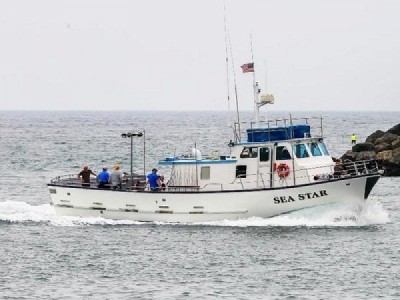
Posted on June 26, 2018
By Phil Diehl, The San Diego Union-Tribune
The entrance of the Oceanside harbor, which missed its spring cleaning this year, is slowly filling with sand and businesses are starting to feel the pinch.
One charter boat company has had to cancel trips for three days so far this month because of the growing underwater sandbar, which makes navigation hazardous in low tides and big swells.
“The harbor mouth is supposed to have a clearance of 26 (feet), and it’s at 20 feet clearance now,” said Donna Kalez, owner of Oceanside Adventures, which runs daily whale-watching and sight-seeing trips on a 50-foot catamaran. “Last month, it was at 22 feet, so it’s filling in rapidly.”
Her business loses thousands of dollars in revenue each day the boat can’t go out, she said.
Another harbor tenant, Boat Rentals of American, can’t rent as many sailboats and powerboats, said assistant manager John Ratcliff.
When the ocean swells are big, they hit the shallower water at the harbor entrance and create waves that can flip a small boat, he said
“We just don’t send them outside the harbor,” Ratcliff said Friday morning. “It definitely hurts our business.”
The man-made harbor requires annual dredging to stay open. Otherwise, tides, waves and sea currents gradually fill the entrance with sand.
Tides vary, but there’s often a difference of six feet or more between the twice-daily highs and lows, so a low-tide crossing brings the biggest waves and can be difficult for boats of all sizes.
Some years at low tide, the entrance can be as shallow as 10 feet or less before dredging begins, boaters have said.
The U.S. Army Corps of Engineers is responsible for the harbor channel maintenance and contracts with the company that does the dredging. This year, the federal agency failed to get the San Diego Regional Water Quality Control Board certification required to begin the annual spring cleaning.
“We met with the Corps a couple weeks ago, and they indicated at the time that the sand levels were at a depth of 20 feet,” Oceanside Public Works Director Kiel Koger said by email Friday.
“We have staff that check it as well on a weekly basis at several locations from a boat equipped with a depth finder,” Koger said. “They have told me recently that the sand levels are still at 20 feet.”
Camp Pendleton Marine Corps Base also has a small harbor and recreational marina just north of Oceanside’s that shares the entrance with the city. A sergeant in the base public affairs office said Thursday she was unaware of any problems at the entrance.
Oceanside city officials were disappointed by the failure to dredge this year as much as anyone. In addition to keeping the harbor open, the dredging project supplies sand to restore the city’s eroding beaches. Healthy beaches protect shoreline homes, streets and parks, and are a big attraction for tourists.
Other charter operators at the harbor said so far this year they’ve had few problems navigating the entrance, perhaps because they own larger boats with conventional hulls unlike the catamaran.
“It just means our captains take extra precautions going over the swells,” said Andrew Marroquin at Helgren’s Sportfishing. “We’re still making it out in the big boats.”
Helgren’s makes about five trips out of the harbor daily. The family-owned company’s largest vessel is 95 feet long and carries as many as 150 people.
“When there’s wind blowing and the surf’s up, that’s when it gets a little sketchy,” Marroquin said. “There’s no way to tell what’s going to happen in July and August.”
Corps of Engineers officials have said the next opportunity for dredging probably will be this fall or early next year.
“The Corps has been monitoring the harbor entrance with hydrographic surveys,” states a May 18 letter from Army Col. Kirk E. Gibbs to Oceanside Mayor Peter Weiss.
“We are also cognizant of the tip shoals that form (at the entrance) on the north and south jetties, which are beginning to encroach on the channel,” Gibbs said. “It is our plan to work with the Harbor Patrol to do monthly depth checks to closely monitor the progression of these tip shoals.”
The Corps’ most recent survey in April showed a depth of 20 feet at the center of the channel, project manager Jim Fields said by email Friday.
“At last check, there was still plenty of room to safely transit the entrance,” Fields said.
Boat captains can see the sand bar building at the edges of the harbor mouth, said Carla Mitroff, manager of Oceanside Adventures.
Each captain decides whether conditions are safe before going out, she said Thursday.
“He has to physically walk down to the rocks,” Mitroff said. “He goes out on the jetty, looks at the swells, reads the weather report” and considers other factors.
A captain has to consider not only whether he can get the boat out of the harbor, but whether he can get back in two or three hours later, she added.
Typically, the annual dredging removes about 250,000 cubic yards of sand from the harbor and delivers it through pipes to the beach.
Last year, on top of the base $3.7 million federal contract, the city paid $600,000 and the Navy and the Corps of Engineers added $625,000 to boost the amount dredged to 440,000 cubic yards. As a result, fresh sand was spread south of the municipal pier for the first time in years.
However, the previous year, 2016, the Corps of Engineers hired a different contractor to do the work and there were problems. The job started late, took months longer than expected and removed less that the usual amount of sand.
Source: The San Diego Union-Tribune





